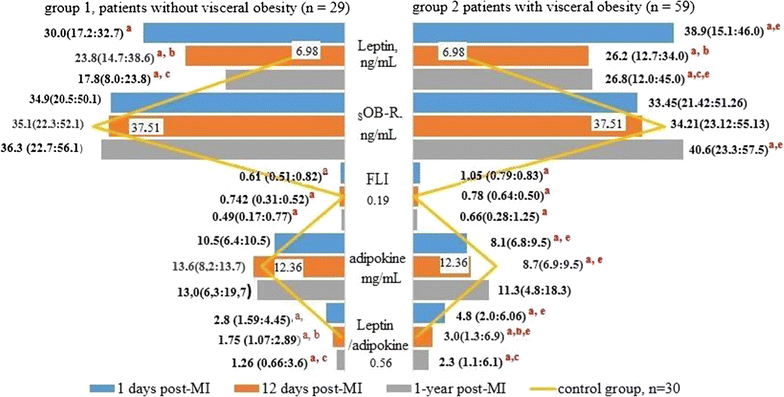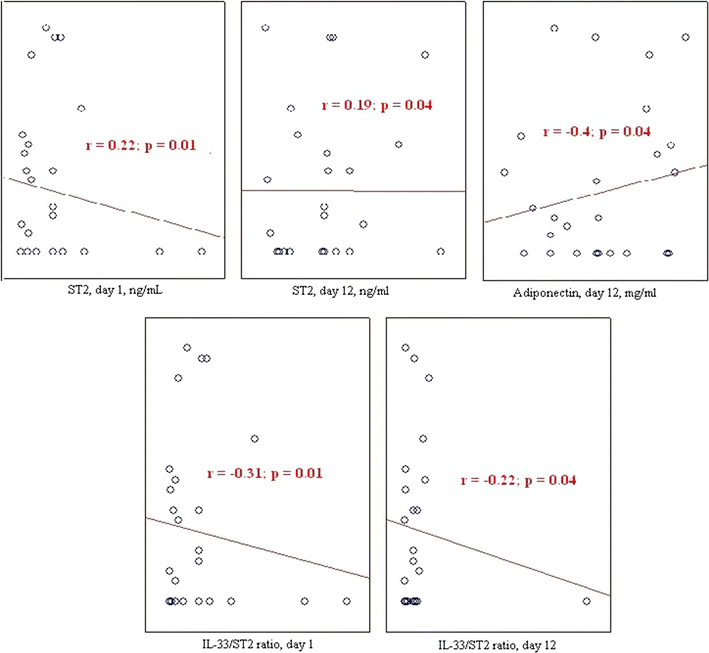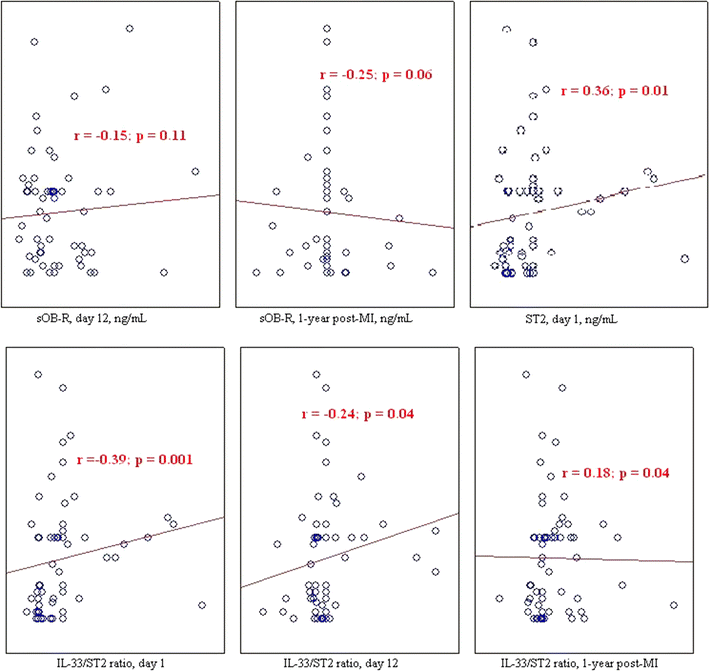Relationships between epicardial adipose tissue thickness and adipo-fibrokine indicator profiles post-myocardial infarction
- PMID: 29548286
- PMCID: PMC5855976
- DOI: 10.1186/s12933-018-0679-y
Relationships between epicardial adipose tissue thickness and adipo-fibrokine indicator profiles post-myocardial infarction
Abstract
Background: Determination of the impact of visceral obesity and epicardial adipose tissue thickness on stimulating growth factor levels during hospitalization for myocardial infarction is of potential importance for predicting outcomes and assessing the development of cardiofibrotic changes associated with maladaptive myocardial remodeling. In this study, we aimed to investigate the relationships between epicardial adipose tissue thickness, adipokine profiles, and the stimulating growth factor 2/interleukin-33 signaling system during hospitalization for myocardial infarction, and with the cardiac fibrosis extent 1-year post-MI in patients with visceral obesity.
Methods: Eighty-eight patients with myocardial infarction were grouped based on their visceral obesity. Serum leptin, adiponectin, stimulating growth factor 2, and interleukin-33 levels were measured on days 1 and 12 and at 1 year. The epicardial adipose tissue widths and the cardiac fibrosis areas were measured on day 12 and at 1 year.
Results: Visceral obesity was associated with epicardial adipose tissue thickness increases, adipokine imbalances, elevated leptin levels, and lower adiponectin levels during early hospitalization, and cardiac fibrosis development. Patients without visceral obesity had higher interleukin-33 and stimulating growth factor 2 levels during early hospitalization and lower cardiac fibrosis rates. Epicardial adipose tissue thickness was positively associated with cardiac fibrosis prevalence and interleukin-33 levels and negatively associated with stimulating growth factor 2 levels. The cardiac fibrosis extent was negatively associated with interleukin-33 levels and positively associated with stimulating growth factor 2 levels.
Conclusions: Increases in epicardial adipose tissue thickness are associated with cardiac fibrosis development 1-year post-myocardial infarction and are higher in patients with visceral obesity. The metabolic activity of the epicardial adipose tissue is associated with elevated interleukin-33 and reduced stimulating growth factor 2 levels.
Keywords: Adiponectin; Cardiac fibrosis; Epicardial adipose tissue; Interleukin-33; Stimulating growth factor 2; Visceral obesity.
Figures





Similar articles
-
The relationship of the epicardial fat and adipo-fibrokines in myocardial infarction.Klin Lab Diagn. 2020 Sep 16;65(9):533-540. doi: 10.18821/0869-2084-2020-65-9-533-540. Klin Lab Diagn. 2020. PMID: 33245637 English.
-
Relation of echocardiographic epicardial fat thickness and myocardial fat.Am J Cardiol. 2010 Jun 15;105(12):1831-5. doi: 10.1016/j.amjcard.2010.01.368. Epub 2010 Apr 27. Am J Cardiol. 2010. PMID: 20538139
-
Epicardial adipose tissue density and volume are related to subclinical atherosclerosis, inflammation and major adverse cardiac events in asymptomatic subjects.J Cardiovasc Comput Tomogr. 2018 Jan-Feb;12(1):67-73. doi: 10.1016/j.jcct.2017.11.007. Epub 2017 Nov 24. J Cardiovasc Comput Tomogr. 2018. PMID: 29233634 Free PMC article.
-
Human epicardial adipose tissue: a review.Am Heart J. 2007 Jun;153(6):907-17. doi: 10.1016/j.ahj.2007.03.019. Am Heart J. 2007. PMID: 17540190 Review.
-
Regulation of visceral and epicardial adipose tissue for preventing cardiovascular injuries associated to obesity and diabetes.Cardiovasc Diabetol. 2017 Apr 4;16(1):44. doi: 10.1186/s12933-017-0528-4. Cardiovasc Diabetol. 2017. PMID: 28376896 Free PMC article. Review.
Cited by
-
Unveiling IL-33/ST2 Pathway Unbalance in Cardiac Remodeling Due to Obesity in Zucker Fatty Rats.Int J Mol Sci. 2023 Jan 19;24(3):1991. doi: 10.3390/ijms24031991. Int J Mol Sci. 2023. PMID: 36768322 Free PMC article.
-
Pulsed electric field ablation process-the effect of bifurcation stents on electric field and heat distribution.Sci Rep. 2025 Jul 14;15(1):25352. doi: 10.1038/s41598-025-10606-w. Sci Rep. 2025. PMID: 40659746 Free PMC article.
-
Analysis of probable lipotoxic damage and myocardial fibrosis in epicardial obesity.Aging (Albany NY). 2021 Jun 4;13(11):14806-14815. doi: 10.18632/aging.203148. Epub 2021 Jun 4. Aging (Albany NY). 2021. PMID: 34088886 Free PMC article.
-
Adipocytes Directly Affect Coronary Artery Disease Pathogenesis via Induction of Adipokine and Cytokine Imbalances.Front Immunol. 2019 Sep 19;10:2163. doi: 10.3389/fimmu.2019.02163. eCollection 2019. Front Immunol. 2019. PMID: 31608050 Free PMC article.
-
Excessive accumulation of epicardial adipose tissue promotes microvascular obstruction formation after myocardial ischemia/reperfusion through modulating macrophages polarization.Cardiovasc Diabetol. 2024 Jul 5;23(1):236. doi: 10.1186/s12933-024-02342-8. Cardiovasc Diabetol. 2024. PMID: 38970123 Free PMC article.
References
Publication types
MeSH terms
Substances
LinkOut - more resources
Full Text Sources
Other Literature Sources
Medical

